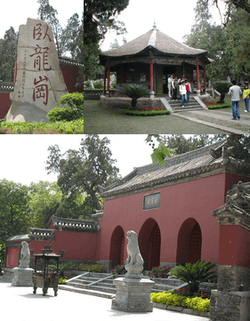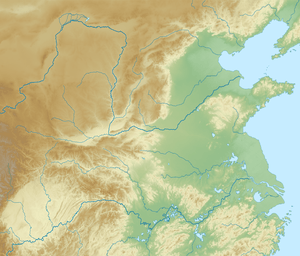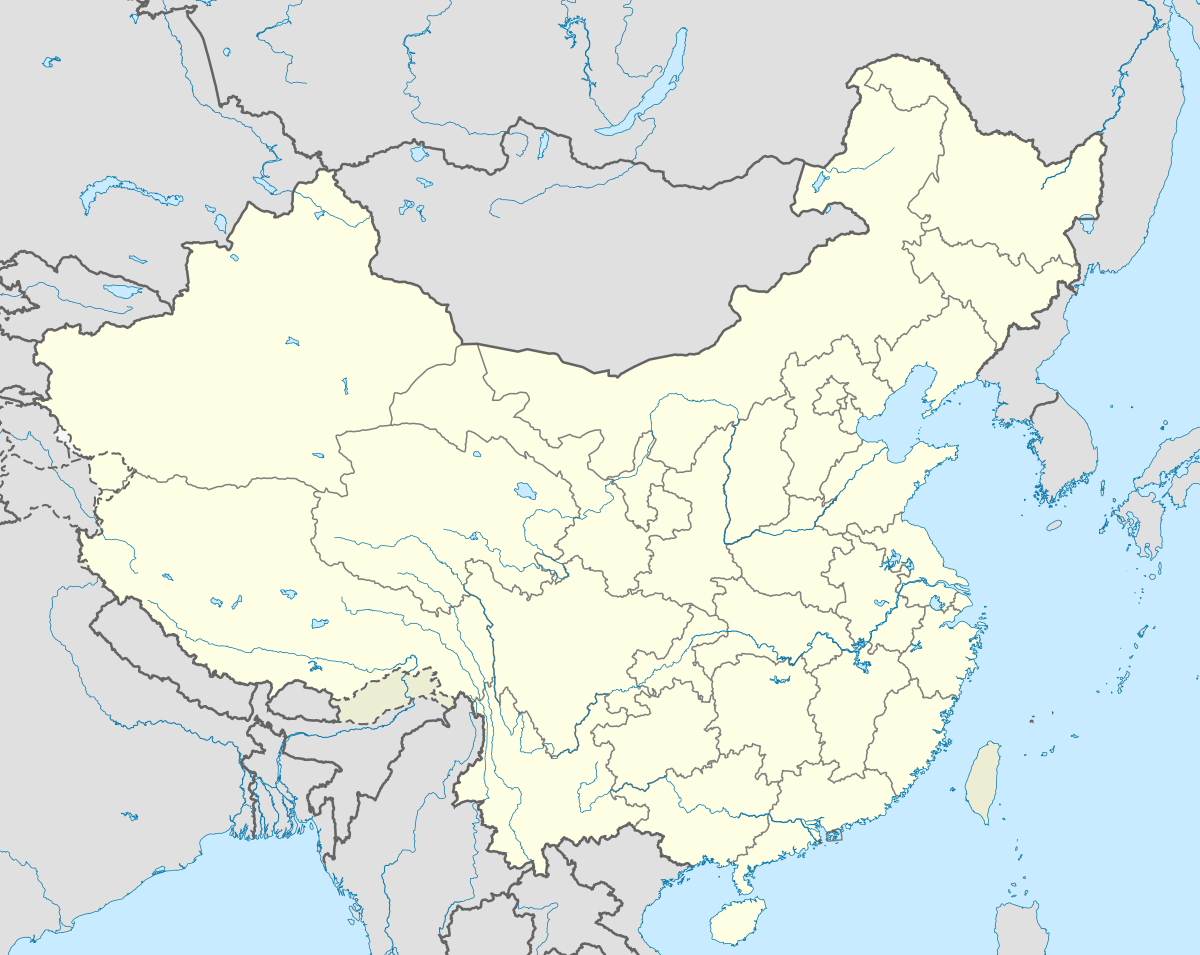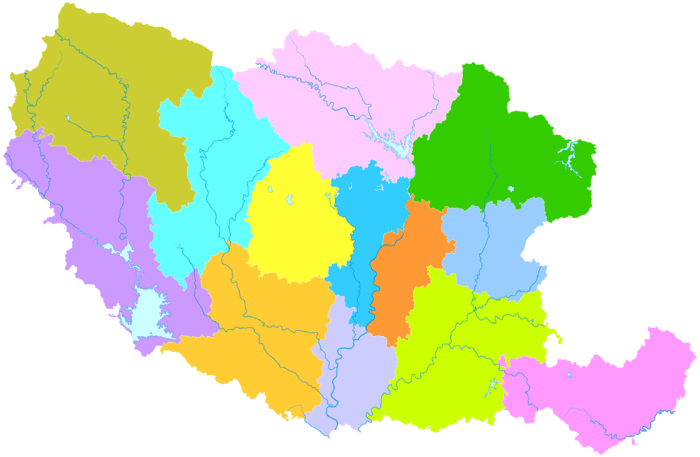Nanyang, Henan
Nanyang (simplified Chinese: 南阳; traditional Chinese: 南陽; pinyin: Nányáng) is a prefecture-level city in the southwest of Henan province, China. The city with the largest administrative area in Henan, Nanyang borders Xinyang to the southeast, Zhumadian to the east, Pingdingshan to the northeast, Luoyang to the north, Sanmenxia to the northwest, the province of Shaanxi to the west, and the province of Hubei to the south.
Nanyang 南阳市 | |
|---|---|
 | |
| Nickname(s): Wan (宛) | |
 Satellite view of Nanyang | |
 Nanyang City in Henan | |
 Nanyang Location on the North China Plain  Nanyang Nanyang (China) | |
| Coordinates (Nanyang municipal government): 32°59′25″N 112°31′43″E | |
| Country | People's Republic of China |
| Province | Henan |
| County-level divisions | 2 districts 10 counties |
| Municipal seat | Wolong District |
| Government | |
| • Mayor | Huo Haosheng |
| Area | |
| • Prefecture-level city | 26,509 km2 (10,235 sq mi) |
| • Urban | 309 km2 (119 sq mi) |
| • Rural | 26,200 km2 (10,100 sq mi) |
| Dimensions | |
| • Length | 263 km (163 mi) |
| • Width | 168 km (104 mi) |
| Elevation | 131 m (430 ft) |
| Highest elevation | 2,212.5 m (7,258.9 ft) |
| Lowest elevation | 72.2 m (236.9 ft) |
| Population (2017)[1] | |
| • Prefecture-level city | 11,942,300 |
| • Density | 450/km2 (1,200/sq mi) |
| • Urban | 2,000,000 |
| • Urban density | 6,500/km2 (17,000/sq mi) |
| • Rural | 9,942,300 |
| • Rural density | 380/km2 (980/sq mi) |
| Time zone | UTC+8 (China Standard) |
| Postal code | 473000 |
| Area code(s) | 0377 |
| ISO 3166 code | CN-HA-13 |
| Major Nationalities | Han |
| License plate prefixes | 豫R |
| Maidenhead locator or QTH grid square | OM62GX - OM63GA |
| City Flowers | Chrysanthemum&China Rose |
| Website | www |
It had 10,263,660 inhabitants at the 2010 census, ranking eleventh in China.[2] However, 1,811,812 residents live in the built-up area made of three urban districts (High-Tech Industrial Development Zone, Wolong and Wancheng).[3] Dinosaur egg fossils have been discovered in the Nanyang Basin.
The 35,000 capacity Nanyang Sports Centre Stadium is the main (football) venue in the city.
Names
Nanyang (simplified Chinese: 南阳; traditional Chinese: 南陽; pinyin: Nányáng) 南-South, 阳/陽-sun (the south side of a mountain, or the north side of a river, which in Chinese is called Yang meaning "sunny"). Wan (宛) is the abbreviation for Nanyang which in ancient times was known as Wancheng (宛城), meaning "Wan City".
Nanyang has been the name of the region since at least the Qin Dynasty. It therefore has the distinction of being one of the oldest continuously used major place names in contemporary China.
History
Nanyang was the capital of the state of Shen in the first millennium BCE. It became commercially important under the Han dynasty, as it had many iron foundries and other manufacturing sites, and also fell at the convergence of routes between major cities. In the Dong Han period, it was known for business and luxury, and was for a time the southern capital. It subsequently declined somewhat in importance, but remained a political and cultural center of southwestern Henan province and a hub for trade.[4]
Geography
Nanyang is located in southwestern Henan, bordering Hubei (Xiangyang, Shiyan, and Suizhou) to the south, Shaanxi (Shangluo) to the west and the following prefecture-level cities in Henan:
- Zhumadian (E)
- Xinyang (SE)
- Sanmenxia (NW)
- Luoyang (N)
- Pingdingshan (NE)
The latitude of the entire prefecture ranges from 32° 17' to 33° 48' N, while the longitude ranges from 110° 58' to 113° 49' E, and the prefecture spans 26,600 square kilometres (10,300 sq mi). The city lies within the Nanyang Basin, which is part of a region in Central China that lies in the gap between the eastern end of the Qin Mountains and the source of the Huai River. Thus, using those two geographic features as the standard dividing line, it is difficult to classify the city into northern or southern China.
To the north of Nanyang city proper, there is a mountain called Mount Du, which is famous for the Dushan jade, one of the four famous jades of China, now a rarity. To the southwest is Neixiang County with the newly developing Baotianman Biosphere Reserve—an area of high biodiversity, with 65 rare and endangered species.

Climate
The climate is generally moderate and is a four-season humid subtropical climate (Köppen Cwa), with strong monsoon influences: winters are cool but dry, and summers are hot and humid. Spring and autumn provide transitions of reasonable length. The monthly daily average temperature in January is 1.4 °C (34.5 °F) and in July it is 26.9 °C (80.4 °F); the annual mean is 14.9 °C (58.8 °F). More than half the annual rainfall occurs from June to August.
| Climate data for Nanyang, Henan (1971−2000) | |||||||||||||
|---|---|---|---|---|---|---|---|---|---|---|---|---|---|
| Month | Jan | Feb | Mar | Apr | May | Jun | Jul | Aug | Sep | Oct | Nov | Dec | Year |
| Record high °C (°F) | 19.5 (67.1) |
22.8 (73.0) |
28.5 (83.3) |
33.2 (91.8) |
37.0 (98.6) |
41.4 (106.5) |
39.7 (103.5) |
39.0 (102.2) |
39.0 (102.2) |
32.9 (91.2) |
28.5 (83.3) |
21.4 (70.5) |
41.4 (106.5) |
| Average high °C (°F) | 6.7 (44.1) |
9.4 (48.9) |
14.0 (57.2) |
21.2 (70.2) |
26.5 (79.7) |
30.8 (87.4) |
31.5 (88.7) |
30.8 (87.4) |
26.7 (80.1) |
21.7 (71.1) |
15.0 (59.0) |
9.0 (48.2) |
20.3 (68.5) |
| Daily mean °C (°F) | 1.4 (34.5) |
3.9 (39.0) |
8.6 (47.5) |
15.5 (59.9) |
20.7 (69.3) |
25.3 (77.5) |
26.9 (80.4) |
26.2 (79.2) |
21.6 (70.9) |
15.9 (60.6) |
9.2 (48.6) |
3.4 (38.1) |
14.9 (58.8) |
| Average low °C (°F) | −2.6 (27.3) |
−0.6 (30.9) |
3.8 (38.8) |
10.2 (50.4) |
15.3 (59.5) |
20.2 (68.4) |
23.2 (73.8) |
22.5 (72.5) |
17.4 (63.3) |
11.3 (52.3) |
4.6 (40.3) |
−0.9 (30.4) |
10.4 (50.7) |
| Record low °C (°F) | −12.8 (9.0) |
−13.9 (7.0) |
−5.3 (22.5) |
−0.4 (31.3) |
5.0 (41.0) |
11.8 (53.2) |
17.2 (63.0) |
15.0 (59.0) |
7.9 (46.2) |
−1.2 (29.8) |
−6.2 (20.8) |
−17.5 (0.5) |
−17.5 (0.5) |
| Average precipitation mm (inches) | 13.7 (0.54) |
16.2 (0.64) |
34.7 (1.37) |
48.8 (1.92) |
73.1 (2.88) |
123.9 (4.88) |
177.8 (7.00) |
114.3 (4.50) |
75.9 (2.99) |
58.1 (2.29) |
29.7 (1.17) |
11.5 (0.45) |
777.7 (30.63) |
| Average precipitation days (≥ 0.1 mm) | 4.5 | 5.0 | 7.9 | 8.1 | 9.5 | 9.9 | 12.3 | 10.4 | 9.2 | 8.8 | 6.0 | 3.8 | 95.4 |
| Source: Weather China | |||||||||||||
Environment
Demographics
The whole city area has a population over 10.26 million, which is the twelfth prefecture-level city in China now. The built-up area has over 1.8 million people, which is the fifth largest city in Henan Province. About 1 million commute from the city, mainly to Zhengzhou, Guangdong province, Beijing and Shanghai. The majority of the province is Han; among the minority nationalities are the Hui people and Man people.
Population
Ethnic groups
Language
Health
Education
Nanyang higher education already has a good foundation for development. Nanyang is a great city of education. It has a fine tradition of respecting teachers and teaching and educating students. It has taken the lead in proposing a strategy of science and education in the country. In particular, in recent years, the municipal party committee and the municipal government have attached great importance to education. The education industry in our city has developed vigorously and the face of higher education has undergone tremendous changes. There are 6 colleges and universities in the city, with nearly 90,000 students. All colleges and universities adhere to the Party's education policy, implement the fundamental tasks of Lide Shuren, and have achieved unprecedented achievements in personnel training, scientific research, social services, cultural heritage innovation and international exchanges and cooperation, which not only promotes the city's science and technology. Innovation, social progress and improvement of people's livelihood have also laid a good foundation for achieving a higher level of development at a new starting point.
Schools and Libraries
Primary education[5]
Secondary education[5]
- No.1 High school of Nanyang (南阳市一中)
- No.2 High School of Nanyang
- No.5 High School of Nanyang
- No.8 High School of Nanyang
Library
- Nanyang Library (南阳市图书馆)
Higher education
- Nanyang Institute of Technology[6](南阳理工学院)
- Nanyang Normal University[7](南阳师范学院)
- Nanyang Medical College[8](南阳医学高等专科学校)
- Henan Polytechnic Institute[9](河南工业职业技术学院)
- Nanyang Vocational College of Agriculture[10](南阳农业职业学院)
Urbanization
Religion
Administration
The prefecture-level city of Nanyang administers 2 districts, 1 county-level city and 10 counties.
- Wolong District (卧龙区)
- Wancheng District (宛城区)
- Dengzhou City (邓州市)
- Xinye County (新野县)
- Sheqi County (社旗县)
- Tanghe County (唐河县)
- Tongbai County (桐柏县)
- Fangcheng County (方城县)
- Nanzhao County (南召县)
- Zhenping County (镇平县)
- Neixiang County (内乡县)
- Xixia County (西峡县)
- Xichuan County (淅川县)
| Map |
|---|
Economy
- Nanyang has a developing cattle industry, as well as a tobacco factory.
- The Bai River flows through Nanyang and provides it with an abundant supply of fish.
- Nanyang produces two kinds of quality wine: Shedianlaojiu and Wolongyuye.
- Nanyang oil field is the second largest oil field in Henan Province.
- Agriculture plays an important role in its economy.
- There is a large optical component production community in the area comprising several factories.
Infrastructure
Transport
Railways
Nanyang has two major railway stations: Nanyang Railway Station and Nanyang East Railway Station. There are also several other small stations serving suburban areas.
Nanyang is a railway junction for the Nanjing-Xi'an Railway and the Jiaozuo-Liuzhou Railway. Direct train service is available to Shanghai, Nanjing, and Hefei to the east, Xian and Lanzhou to the west, Luoyang to the north and Liuzhou to the south. Nanyang East Railway Station is a railway station on Zhengzhou–Wanzhou high-speed railway. Direct train service is available to Beijing, Shanghai, and Zhengzhou.
Highways and expressways
Over 500 km (310 mi) of highway network has been built along the railway line and others. An 80 km (50 mi) beltway is being constructed surrounding the city. As of 2009, feasibility studies for 80 km (50 mi) of elevated rope suspension pathways hanging 10 meters high for pedestrian and bicycle use have been approved by city level governance. Installation will begin early 2010.
China National Highway
- China National Highway 207
- China National Highway 234
- China National Highway 311
- China National Highway 312
China National Expressway
Henan Provincial Expressways
- S81 Shangqiu–Nanyang Expressway
- S83 Lankao–Nanyang Expressway
- S98 Neixiang–Dengzhou Expressway
Airport and airlines
Nanyang Airport is one of three civil aviation airports in the province. It is only 20 minutes bus time from the urban area. Passengers can take flights to and from Beijing, Shanghai, Guangzhou, Shenzhen, and Guilin.
There are also two avion airports.
Public transit
Nanyang city buses have about 30 lines in the urban area. Taxis are common.
Culture

The official language of Nanyang is Mandarin Chinese, but most locals speak the Henan dialect, with its easily identifiable stereotypical features; this local dialect is known as Nanyang Hua (南阳话), and is spoken by about 15 million people in the area.
There is also a local form of Chinese opera called Wan Opera.
Famous people from Nanyang
- Zhang Heng, Eastern Han Dynasty astronomer, mathematician and inventor of the first seismometer in history.
- Zhang Zhongjing, late Eastern Han Dynasty physician and pharmacist.
- Zhuge Liang, renowned adviser to Liu Bei and the first chancellor of the Shu Han during the Three Kingdoms era.
- Gan Ning, general of Wu during the Three Kingdoms, born in Nanyang.
- Han Yu, Tang Dynasty poet.
- Huang Zhong, a leading military general of the Shu Han ruled by Liu Bei during the Three Kingdoms era, was one of the Five Tiger Generals of Shu.
- Chang Wanquan, the current Minister of National Defense of China, former Director of the General Armaments Department and commander of the Shenyang Military Region, born in January 1949 in Nanyang
- Er Yuehe, writer
- Feng Youlan, philosopher
- Yao Xueyin, writer
- Wang Yongmin, computer scientist
Within the metropolitan area
Temples, cathedrals, and mosques
- Wolong Gang
- Nanyang Mansion (Ming & Qing Dynasty)
- Temple of holy doctor Zhang Zhongjing
- Zhang Heng's Grave (Han Dynasty)
- Art Museum of Stone Portrait and Carvings of Han Dynasty (汉画馆)
Outside the metropolitan area, but within the municipality
Temples, cathedrals, and mosques
- Jingziguan in Xichuan County is a historical and cultural town.
- Neixiang County Mansion (Ming & Qing Dynasty)
- Sheqi Meeting Place (Qing Dynasty)
- Dengzhou Huazhou College
Sights
- Funiu Shan World Geology Park
- Danjiangkou Reservoir
- Tongbai Water-Curtain Cave Temple
- Shiren Mountain
- Wu Hou Ci
See also
References
- http://www.nanyang.gov.cn/sqgl.htm
- 最新中国城市人口数量排名(根据2010年第六次人口普查). www.elivecity.cn. 2012. Retrieved 2014-05-28.
- "China: Hénán (Prefectures, Cities, Districts and Counties) - Population Statistics, Charts and Map". www.citypopulation.de.
- "Nanyang | China". Encyclopedia Britannica. Retrieved 2020-02-19.
- http://www.nyedu.net/plus/view.php?aid=44430 schools of Education bureau
- English-南阳理工学院. Nanyang Institute of Technology.
- "Welcome to Nanyang Normal University". www2.nynu.edu.cn.
- http://www.nymc.edu.cn/ (Chinese)
- http://www.hnpi.cn/ (Chinese)
- http://www.nyac.cn/ (Chinese)
- Ayscough, Florence. 1939. “An Uncommon Aspect of Han Sculpture: Figures from Nan-yang”. Monumenta Serica 4 (1). Maney Publishing: 334–44. An Uncommon Aspect of Han Sculpture: Figures from Nan-yang.
Further reading
External links
| Wikimedia Commons has media related to Nanyang, Henan. |
- Government website of Nanyang (in Chinese)
- Government website of Nanyang (in English)
